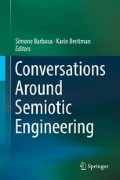Abstract
The fundamental contribution of Semiotic Engineering to human-computer interaction (HCI) has been to propose and establish a discourse to conceptualize HCI not primarily about how users interact with computers but as computer-mediated communication between designers and users at interaction time. It represents an important contribution to explore the future of HCI beyond the focus of usability and interfaces. In our own research over the last few decades, we have also explored alternative approaches to create richer frameworks and ecologies on how designers and users can interact in the design of computational artifacts. This contribution briefly describes some of these approaches by characterizing the problems that they addressed and the potential solutions that they explored.
Access this chapter
Tax calculation will be finalised at checkout
Purchases are for personal use only
References
Arias EG, Eden H, Fischer G (2016) The Envisionment and Discovery Collaboratory (EDC): explorations in human-centered informatics. Morgan & Claypool Publishers, San Rafael
Benkler Y (2006) The wealth of networks: how social production transforms markets and freedom. Yale University Press, New Haven
Binder T, DeMichelis G, Ehn P, Jacucci G, Linde P, Wagner I (2011) Design things. MIT Press, Cambridge, MA
Buxton W (2002) Less is more (more or less). In: Denning PJ (ed) The invisible future – the seamless integration of technology in everyday life. McGraw-Hill, New York, pp 145–179
Curtis B, Krasner H, Iscoe N (1988) A field study of the software design process for large systems. Commun ACM 31(11):1268–1287
De Souza CS, Cerqueira RF d G, Afonso LM, Brandão RR d M, Ferreira JSJ (2016) Software developers as users: semiotic investigations in human-centered software development. Springer, New York
De Souza CS, Leitao CF (2009) Semiotic enginnering methods for scientific research in HCI. Morgan & Claypool Publishers, San Rafael
Fischer G (1993) Beyond human computer interaction: designing useful and usable computational environments. In: People and computers VIII: proceedings of the HCI’93 conference (Loughborough, England). Cambridge University Press, Cambridge, UK, pp 17–31
Fischer G (2011) Understanding, fostering, and supporting cultures of participation, ACM Interac XVIII. 3 (May + June 2011), pp 42–53
Fischer G, Giaccardi E (2006) Meta-design: a framework for the future of end user development. In: Lieberman H, Paternò F, Wulf V (eds) End user development. Kluwer Academic Publishers, Dordrecht, pp 427–457
Fischer G, Lemke AC (1988) Construction kits and design environments: steps toward human problem-domain communication. Human Comp Interac 3(3):179–222
Fischer G, Rathke C (1988) Knowledge-Based spreadsheet systems. In: Proceedings of AAAI-88, seventh national conference on artificial intelligence (St. Paul Mn), Morgan Kaufmann Publishers, San Mateo, pp 802–807
Fischer G, Nakakoji K (1992) Beyond the macho approach of artificial intelligence: empower human designers – do not replace them. Knowledge Based Syst J, Special Issue on AI in Design 5(1):15–30
Furnas GW, Landauer TK, Gomez LM, Dumais ST (1987) Vocabulary problem in human-system communication. Commun ACM 30(11):964–971
Greenberg S, Buxton B (2008) Usability evaluation considered harmful (some of the time). In: CHI 2008 proceedings. ACM, Florence, pp 111–120
Kintsch W (1998) Comprehension: a paradigm for cognition. Cambridge University Press, Cambridge, UK
Lieberman H, Paterno F, Wulf V (eds) (2006) End user development. Kluwer Publishers, Dordrecht
Nardi BA (1993) A small matter of programming. The MIT Press, Cambridge, MA
Newell A, Card SK (1985) The prospects for psychological science in human-computer interaction. Human-Computer Interaction 1(3):209–242
Norman D (1991) Cognitive artifacts. In: Carroll JM (ed) Designing interaction. Cambridge University Press, Cambridge, pp 17–38
Norman DA, Draper SW (eds) (1986) User-centered system design, new perspectives on human-computer interaction. Lawrence Erlbaum Associates Inc, Hillsdale
Popper KR (1959) The logic of scientific discovery. Basic Books, New York
Schön DA (1983) The reflective practitioner: how professionals think in action. Basic Books, New York
Shneiderman B (2007) Creativity support tools: accelerating discovery and innovation. Commun ACM 50(12):20–32
Suchman LA (1987) Plans and situated actions. Cambridge University Press, Cambridge, UK
Thaler RH, Sunstein CR (2009) Nudge—improving decisions about health, wealth, an happiness. Penguin Books, London
Williams MD (1984) What makes rabbit run? Int J Man Machine Stud 21:333–352
Author information
Authors and Affiliations
Corresponding author
Editor information
Editors and Affiliations
Rights and permissions
Copyright information
© 2017 Springer International Publishing AG
About this chapter
Cite this chapter
Fischer, G. (2017). Exploring Richer Ecologies Between Designers and Users. In: Diniz Junqueira Barbosa, S., Breitman, K. (eds) Conversations Around Semiotic Engineering. Springer, Cham. https://doi.org/10.1007/978-3-319-56291-9_4
Download citation
DOI: https://doi.org/10.1007/978-3-319-56291-9_4
Published:
Publisher Name: Springer, Cham
Print ISBN: 978-3-319-56290-2
Online ISBN: 978-3-319-56291-9
eBook Packages: Computer ScienceComputer Science (R0)

